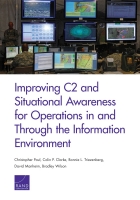by Christopher Paul, Colin P. Clarke, Bonnie L. Triezenberg, David Manheim, Bradley Wilson
Research Questions
How should geographic combatant commands organize to maintain C2 and situational awareness of the IE?
The information environment (IE) is not a physical place and has not yet been defined as a warfighting domain in U.S. military doctrine. Targets of operations in and through the IE include human perceptions or behaviors: Weapons are ideas, and defenses are norms, beliefs, and traditions.
Adding to the complexity of achieving command and control (C2) and situational awareness of the IE is the fact that the U.S. Department of Defense (DoD) has not effectively integrated the IE into operational planning, doctrine, or processes, instead considering traditional land, air, and sea operations separately from operations in the information space. However, every military activity has inherent informational aspects, and adversaries are increasingly using propaganda, misinformation, and other means to influence public perceptions, alliances, and decisions.
Drawing on a review of doctrine and processes, the history of information operations and information-related capabilities, and interviews with subject-matter experts and stakeholders, this report presents a three-tiered vision for the role of information in U.S. military operations. It also identifies requirements for achieving effective C2 and situational awareness of the IE and presents a detailed analysis of seven ways to organize for this objective. Ultimately, addressing the gaps and shortfalls identified in this report will require a much stronger understanding of the IE, associated concepts and capabilities, and roles and responsibilities across the joint force.
Key Findings
The IE is often an afterthought and not given significant attention for the purposes of C2, situational awareness, and intelligence collection
Information and information-related capabilities play a critical role across the full spectrum of military operations.
When the IE is considered in military planning, it is in the context of campaigns to influence noncombatant populations rather than operations targeting adversaries and adversary leaders.
There are major shortfalls in how IE activities are visualized and communicated to commanders and the extent to which the IE is considered in operational planning and organization.
There are opportunities to improve C2 and situational awareness and place a greater emphasis on the IE
Existing doctrine and processes could easily accommodate a greater focus on the IE.
Current practice for C2 and situational awareness has resulted in significant seams when it comes to the IE — areas that either overlap with or fail to cover the roles and responsibilities of those tasked with these operations.
Situational awareness solutions for the IE are not one-size-fits-all. Different commands have different mission priorities and operating contexts.
Situational awareness is subject to human limitations and information overload. Possible solutions include automated processes and machine learning.
Recommendations
DoD should make changes to doctrine, processes, education and training, and tactics, techniques, and procedures to emphasize the importance of the IE and its role in military operations and to address seams in roles and responsibilities.
DoD should always consider the IE and behavior-related objectives in decisions about joint force staffing and operations, making changes to doctrine and processes as needed.
When geographic combatant commands staff and organize for C2 of the IE, they should choose approaches that align with the priorities of their specific theater.
DoD and commands should select innovative, customizable tools to improve how the IE is visualized, making it easier to identify progress and determine how activities support or are supported by other types of military operations.
The DoD intelligence apparatus and the supporting intelligence community should refocus existing capabilities and develop new ones to better observe the IE, with a particular emphasis on the proclivities, intentions, and decisionmaking processes of adversaries and other relevant actors.
Future research should refine requirements for C2 and situational awareness in light of emerging concepts and should capture a wider range of scenarios, echelons, and requirements for intelligence support for operations in and through the IE.

No comments:
Post a Comment